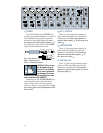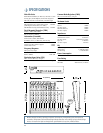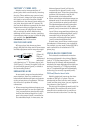
24
AUX 1 SELECT
Besides being used to work effects into your
mix, Aux Sends serve another critical role —
that of delivering cue mixes to stage monitors,
so musicians can hear what they’re doing. On
the 1402-VLZ
PRO,
AUX SEND 1
can play ei-
ther role, depending on the position of this
switch.
With the
AUX 1 SELECT
switch up (disen-
gaged),
AUX SEND 1
will tap a channel
pre-
FADER
and pre-
MUTE/ALT 3-4
, meaning
that no matter how you manipulate those con-
trols as they feed the
MAIN MIX
, the
AUX
SEND
will continue to belt out a constant sig-
nal level. This is the preferred method for
setting up stage monitor feeds.
EQ
settings
will affect all
AUX SENDS
.
With the switch down,
AUX SEND 1
be-
comes an ordinary effects send — post-
FADER
and post-
MUTE/ALT 3-4
. This is a must for ef-
fects sends, since you want the levels of your
“wet” signals to follow the level of the “dry.”
AUX 1 MASTER
The
AUX 1 MASTER
provides overall level
control of
AUX SEND 1
, just before it’s deliv-
ered to the
AUX 1 OUTPUT
. (
AUX SEND 2
has
no such control.) This knob goes from off
(turned fully down), to Unity gain at the center
detent, with 10dB of extra gain (turned fully
up). As with some other level controls, you may
never need the additional gain, but if you ever
do, you’ll be glad you bought a Mackie.
This is usually the knob you turn up when
the lead singer glares at you, points at his
stage monitor, and sticks his thumb up in the
air. (It would follow suit that if the singer
stuck his thumb down, you’d turn the knob
down, but that never happens.)
AUX RETURNS
These two controls set the overall level of
effects received from
STEREO AUX RETURN
in-
puts
1
and
2
. These controls are designed to
handle a wide range of signal levels, from off, to
unity gain at the detent, with 20dB gain fully
clockwise, to compensate for low-level effects.
Typically, these knobs can just live at the
center detent, and the effects device’s output
control should be set at whatever they call
Unity gain (check their manual). If that turns
out to be too loud or too quiet, adjust the ef-
fects device’s outputs, not the mixer. That way,
the mixer’s knobs are easy to relocate at the
center detent.
AUX TALK
First of all, there is no par-
ticular alliance between
AUX
SEND 1
(or
2
) and
AUX
RETURN 1
(or
2
). They’re
just numbers. They’re like two complete
strangers, both named Fred.
Here’s the whole idea behind sends and re-
turns: sends are outputs, returns are inputs.
AUX SEND
s tap signals off the channels, via
their
AUX
knobs , mix these signals, then
send them out via the
AUX SEND
jacks .
These outputs are fed to the inputs of a re-
verb or other device. From there, the outputs of
this external device are fed back to the mixer’s
AUX RETURN
jacks . Then these signals are
sent through the
AUX RETURN
level controls,
and finally delivered to the
MAIN MIX.
So, the original “dry” signals go from the
channels to the
MAIN MIX
and the affected
“wet” signals go from the Aux Returns to the
MAIN MIX
, and once mixed together, the dry
and wet signals combine to create a glorious
sound. So, armed with this knowledge, let’s
visit the Auxiliary World:
30
20
OO
40
50
60
30
20
OO
40
50
60
dB
10
5
5
U
10
dB
10
5
5
U
10
U
OO
+10
U
U
OO
+20
OO
+20
28
10
7
4
2
0
2
4
7
10
20
30
LEVEL
SET
LEFT RIGHT
MAIN MIX
SOLO
MODE
LEVEL SET (PFL)
NORMAL (AFL)
C-R/SOURCE
POWER
PHANTOM
RUDE
SOLO
LIGHT
AUX 1
SELECT
EFX TO
MONITOR
AUX 1 MASTER
AUX
RETURN
1
2
PRE
POST
MAIN MIX
CTL ROOM
/SUBMIX
NORMALLED
0dB=0dBu
ALT 3
–
4
TAPE
ASSIGN
TO MAIN MIX


















